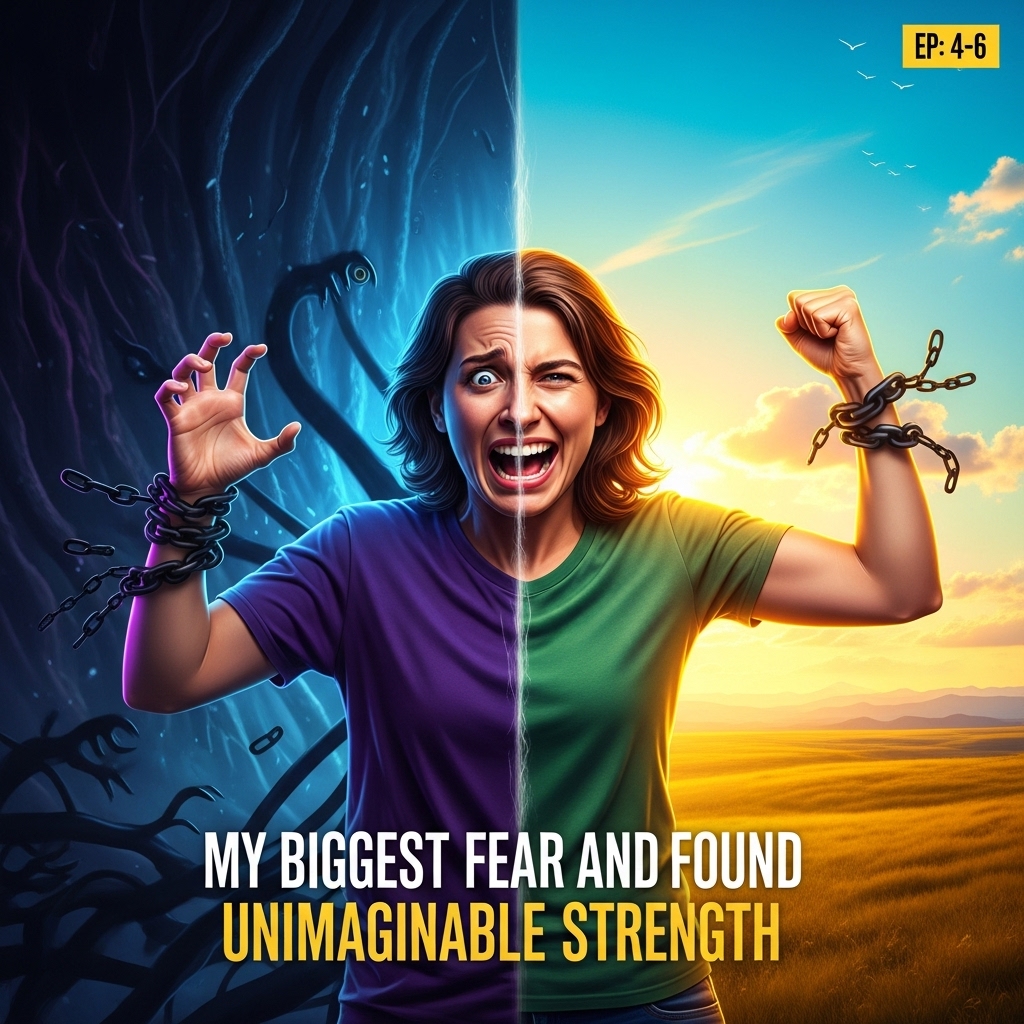Episode: 4
This wasn’t an isolated incident. There were other moments, smaller ones, but each adding to the cumulative weight. Being called upon unexpectedly in class, the blood rushing to my ears, the suddeninability to formulate a coherent thought. Being asked to read aloud, my voice cracking, my breath catching. These weren’t grand traumas, but rather a slow, steady accretion of experiences that whispered the same message: *you are not safe whenyou are seen*.
The peer dynamics of those years also played a crucial, reinforcing role. The playground could be a brutal landscape of unspoken rules and shifting alliances. While I was never truly bullied in a sustained, aggressive way, I oftenfelt on the periphery, observing rather than participating fully. The fear of saying the wrong thing, of looking awkward, of not being “cool” enough, kept me contained. I remember watching groups of children play tag or chase, their laughter ringingfreely, wishing I could join, but the invisible chains of anxiety held me back. What if I tripped? What if I made a clumsy move? What if I said something silly? The stakes, in my mind, felt impossibly high. So, I often chose the safety of the sidelines, reinforcing the narrative that I was different, that I didn’t quite belong, that my true self was best kept hidden. This became a self-perpetuating cycle: fear led to avoidance, avoidanceled to isolation, and isolation further cemented the fear that I wasn’t capable of navigating social waters successfully.
As I moved into middle school, the social landscape became even more complex and unforgiving. Cliques formed, friendships became moreintricate, and the pressure to conform, to present a polished, confident facade, intensified. My fear, which had been a quiet hum, now began to pulsate with a more insistent rhythm. Performance anxiety, which had first manifested as a tremblinghand during show and tell, now extended its icy grip to almost any situation where I might be evaluated or observed.
I remember a particular moment during a school play audition. I loved acting, loved the *idea* of disappearing into a character, but the audition itself was pure torture. Standing alone on the stage, the bright lights blinding me, the faces of the drama teacher and a few other students a blur in the darkness of the auditorium. I had painstakingly memorized a monologue, practicedit countless times in front of my bedroom mirror, my voice strong and clear. But when it was my turn, when those few expectant eyes turned to me, the familiar constriction began. My heart hammered, my breath hitched, and the words,so readily available moments before, now felt lodged in my throat. I delivered a stilted, barely audible performance, my body rigid, my eyes darting frantically. The teacher was kind, but I saw the disappointment in her gaze, asubtle flicker that confirmed my deepest fears. I hadn’t just forgotten lines; I had failed to *be* present, to inhabit the moment, to transcend my own self-consciousness. It wasn’t a lack of talent, I nowbelieve, but an overwhelming internal siege, a mutiny of my own nervous system. After that, I largely retreated from such opportunities, telling myself I simply wasn’t “good enough,” when the truth was, I was too afraid to exposemyself to that kind of internal collapse again.
These weren’t just isolated events; they were the bricks and mortar of a carefully constructed prison of belief. Each perceived failure, each moment of public discomfort, contributed to a deeply ingrained narrative:”I am inherently anxious,” “I cannot handle public situations,” “People will always judge me harshly if they see my true vulnerability.” This internal critic, once a faint whisper, grew into a booming, relentless voice, an omnipresent commentatoron my every move, especially in social contexts. It would anticipate failure before it even happened, poisoning any potential experience with dread.
As I transitioned into adolescence and young adulthood, the demands of life only amplified these fears. Dating, job interviews,presenting projects in college, even simple social gatherings with new people—each became a gauntlet to be navigated with immense internal trepidation. My world began to shrink. I became a master of avoidance, an expert at constructing elaborate excuses to circumventsituations that might trigger my anxiety. “I’m busy that night,” “I have a cold,” “I’m not feeling up to it.” These became my default responses, a shield against the perceived threat of exposure.
The sadirony was that this avoidance, while offering temporary relief, only served to strengthen the fear. Each avoided situation reinforced the idea that the threat was indeed real, that I couldn’t handle it, and that escape was the only viable option. The neuralpathways of anxiety became deeper, more entrenched. My body learned to anticipate these situations with a cascade of physical symptoms—the trembling, the sweating, the racing heart, the feeling of lightheadedness. And then, the *fear of these symptoms* became a trigger in itself. The thought, “What if I start shaking?” would often be enough to *make* me start shaking, creating a cruel, self-fulfilling prophecy. This physiological component was particularly insidious. It wasn’t just a psychological battle; it was a physical betrayal, my own body seemingly conspiring against me, making it impossible to hide my distress.
I remember a particularly vivid, agonizing incident during my college years. I was in a small, intimate seminar class, perhaps only ten students, led by a brilliant but somewhat intimidating professor. We were discussing a complex philosophical text, and each student was expected to contribute meaningfully. My turn to speak was approaching, and I could feel thefamiliar chill begin to creep through my veins. My mind, usually sharp, became a swirling vortex of disconnected thoughts. My mouth felt dry, my throat tight. As the discussion moved closer to me, the physical symptoms surged. My hands,resting on my textbook, began to tremble uncontrollably. My heart pounded so loudly I was sure everyone in the room could hear it. A bead of sweat trickled down my temple. I tried desperately to appear calm, to clench my hands,to breathe deeply, but it felt like my body had completely decoupled from my will.
When the professor finally called on me, I managed to stammer out a few fragmented sentences, my voice barely a whisper, my eyes fixed on the tablein front of me. I could feel the heat radiating from my face, the shame burning me from the inside out. The professor, observing my distress, quickly moved on to another student, a gesture of kindness that only amplified my humiliation. I spentthe remainder of that class in a haze of self-loathing, utterly convinced that I had confirmed every negative belief about myself. The fear wasn’t just about failing intellectually; it was about the raw, visceral exposure of my internal breakdown, the inability to control my own physical reactions, which felt like a profound personal failing. This moment, like the show and tell incident, became another powerful anchor, weighing down my self-perception and reinforcing the deep-seated conviction that I was fundamentallyflawed when under scrutiny.
Episode: 5
This wasn’t a genetic predisposition in the sense of a direct, inherited illness, but I do believe there was a temperamental sensitivity, a natural inclination towards a more reactive nervous system, that, when combined with theseformative experiences, created the perfect storm. It was as if my internal alarm system was set to an impossibly high sensitivity, constantly on edge, ready to sound at the slightest hint of perceived threat. And each time it sounded, and Ireacted with fear and avoidance, it recalibrated itself to be even *more* sensitive.
The historical roots of my fear, therefore, were not singular, but a dense, interlocking web of experiences, beliefs, and physiological responses.
**The “Good Child” conditioning:** The subtle pressure to be agreeable, to not make waves, inadvertently taught me that my authentic, possibly messy or loud, self was unacceptable. This created an internal censor, a constant editor of my words and actions, lestI cause discomfort or draw negative attention.
**Early Public Incidents:** The show and tell, the school play audition, the college seminar—these were not just isolated embarrassments. They were pivotal moments where my internal experience of anxiety was externalized and observed, confirming my fears of public scrutiny and the betrayal of my own body. They taught me that my internal struggles were visible, and therefore, vulnerable to judgment.
**The Reinforcement of Avoidance:** Each time I successfullydodged a social event or a presentation, a tiny, insidious reward center in my brain lit up, reinforcing the maladaptive coping mechanism. The immediate relief of avoidance, however fleeting, felt like a victory, cementing the belief that runningaway was the best, perhaps only, solution. This led to a gradual constriction of my life, a retreat from spontaneity and new experiences. My comfort zone became smaller and smaller, until it felt like a tiny, suffocating box.
**TheInternal Critic:** Over years, the narrative I constructed about myself became powerfully negative. The internal critic, born from those early perceived failures, grew louder and more authoritative. It was the voice that would tell me, *before* any social interaction, “You’re going to mess this up. You’ll stumble over your words. Everyone will see how nervous you are. Just don’t say anything.” This voice, ironically, felt like it was trying to protect me, to warnme of danger, but in reality, it was a saboteur, stripping me of confidence before I even began.
**The Physiological Feedback Loop:** The actual physical symptoms of anxiety—the shaking, sweating, racing heart—became triggers in themselves. Thefear of *experiencing* these symptoms publicly became as potent, if not more potent, than the original social fear. This created a cruel cycle: anticipation of symptoms led to symptoms, which led to greater fear of anticipation. It was a self-fulfilling prophecy played out in the theatre of my own nervous system. My body became an unpredictable enemy, capable of betraying me at any moment.
**The Shrinking World:** As my fear solidified, my capacity for spontaneity and genuine connection diminished. I missed out on countless opportunities—parties, trips, networking events, even simple conversations—because the perceived threat of anxiety loomed too large. I developed a meticulously crafted persona designed to deflect attention, to appear calm and collected, butbeneath the surface, a constant storm raged. This facade, while protective, also created a deep sense of inauthenticity, a feeling that no one truly knew the real me, further intensifying my isolation. The emotional cost of maintaining this falseself was immense, leading to chronic exhaustion and a pervasive sense of emptiness.
So, when I finally began to truly *see* my fear, to define it as a separate entity, it wasn’t a simple beast with a single originpoint. It was a hydra, with many heads, each representing a historical trigger, a reinforcing belief, a physiological response, all intertwined. Understanding this genesis, painstakingly piecing together the timeline of its development, was not just an intellectual exercise. Itwas a crucial act of self-archaeology. It allowed me to de-personalize the fear, to recognize that it wasn’t an inherent flaw in my character, but a learned response, a complex architecture built over years fromthese specific bricks and mortar.
This excavation of the past, while painful in its dredging up of old embarrassments and deep-seated insecurities, was also incredibly liberating. It allowed me to map the territory, to understand the intricate design of theprison I had built around myself, brick by careful brick. And in that understanding, for the very first time, I began to glimpse the faint outline of an escape route. It was the crucial first step in realizing that if something was *built*, it could also be *unbuilt*. If something was *learned*, it could also be *unlearned*. The shadow, which had felt like an inescapable part of my identity, began to reveal its constructed nature. It showed itselfto be a story I had been telling myself, a narrative reinforced by a lifetime of experiences, and the very first whisper of hope came with the dawning realization that stories, however deeply ingrained, can always be rewritten. This journey into the past, therefore, was not about dwelling in old wounds, but about understanding the blueprints of my fear, recognizing its architecture, and preparing the ground for the reconstruction of a new, stronger, and more authentic self.The realization that stories, however deeply ingrained, can always be rewritten. This journey into the past, therefore, was not about dwelling in old wounds, but about understanding the blueprints of my fear, recognizing its architecture, and preparing the ground forthe reconstruction of a new, stronger, and more authentic self.
**The First Forays: Initial Attempts to Confront the Fear and the Inevitable Setbacks**
With the blueprints in hand, the initial burst of hope was intoxicating. It was like standing before a complex, imposing structure that had held me captive for so long, suddenly seeing the faint, almost invisible lines where the mortar was weakest, where a brick *could* be removed. The intellectual understanding, the painstakingself-archaeology, had provided a map, a theory, a grand strategy. The next logical step, I told myself, was to put that theory into practice. It felt like an urgent, exhilarating call to action, a mandatefrom my newfound, nascent self.
My first forays were tentative, almost experimental. They weren’t grand, dramatic gestures visible to the world, but small, internal skirmishes fought in the quiet theater of my own mind and inlow-stakes social situations. I started with the most accessible “bricks” in my self-made prison: the small, daily acts of self-effacement, the ingrained habits of agreement, the instinct to fade into the background.
Episode: 6
Oneof the earliest attempts involved something as seemingly trivial as ordering coffee. For years, I had a specific, somewhat complicated coffee order, but more often than not, I would default to a simpler, less desired option if the line was long, ifthe barista seemed busy, or if I just felt a prickle of self-consciousness. My fear told me: *Don’t bother them. Don’t be a nuisance. Your preferences aren’t important enough to warrant extra effort.* So, my first “foray” was to simply order *my* coffee, exactly as I liked it, without apology or hesitation. The tremor in my voice as I articulated “a large iced latte with oat milk, two pumps of sugar-free vanilla, and a single shot of espresso” felt disproportionate to the task. It was just coffee. But in that moment, it was a declaration. And when the barista didn’t scowl, didn’t roll their eyes, butsimply nodded and typed it in, a tiny, almost imperceptible shift occurred. It was a victory, minuscule but real.
Encouraged by such small triumphs, I began to push a little further. I tried to voice a genuine opinion in acasual conversation with a friend, rather than just agreeing. I attempted to initiate a social gathering, something I almost never did, always waiting to be invited. These were not challenges that would make headlines, but for someone whose fear had manifested as aconstant suppression of self, they felt monumental. Each small act was a tiny chip away at the edifice of my constructed personality, a whisper of authenticity pushing through the practiced facade.
But the “shadow,” as I had come to call mydeep-seated fear, was not so easily vanquished. It had spent decades weaving itself into the very fabric of my being, and it possessed an insidious intelligence. It didn’t just disappear because I understood its origins. It fought back.And it fought back with cunning, with subtlety, and with a particular mastery of psychological warfare.
The inevitable setbacks began to accumulate, chipping away at my nascent hope with a relentless precision that often felt more debilitating than the initial fear itself.I remember one specific instance, early on, when I attempted to be more assertive in a work meeting. My fear of judgment, of appearing foolish or incompetent, had always kept me quiet, observing rather than participating actively. I’d sitthere, ideas bubbling in my mind, perfectly valid points, yet they’d die on my tongue. This time, armed with my new understanding, I resolved to speak up.
I rehearsed my points internally, bolstered by the convictionthat my perspective was valuable. When the opportunity arose, I took a deep breath, and I spoke. The words came out, perhaps a little too fast, a little too strained, but they were out. And then, a colleague, someonewhose opinion I valued, responded with a dismissive wave of their hand and a curt, “I think we’ve already covered that, haven’t we?” They weren’t overtly hostile, but the casual dismissal felt like a physical blow. Theblood rushed from my face. My carefully constructed argument crumbled, not because it was flawed, but because the delivery was still fragile, and the reception was not what I had hoped for.
In that moment, the shadow resurfaced with avengeance. It whispered, *See? I told you so. You’re not smart enough. Your ideas aren’t original. You should have just stayed quiet. You’re bothering people.* The shame was immediate and overwhelming. It wasn’t just disappointment; it was a profound sense of humiliation, a confirmation of every negative belief I had ever held about myself. I felt my energy drain away, replaced by a cold, heavy blanket of self-doubt. For the rest of thatmeeting, I shrank, retreating deeper into myself than before. The fragile brick I had tried to remove seemed to snap back into place with reinforced steel, trapping me more firmly than ever.
The immediate aftermath of such setbacks was a predictable spiral. The initial rush of self-reproach would quickly morph into a profound sense of weariness. *Why bother?* my mind would argue. *It’s too hard. This is just who you are. You can’t changethis fundamental part of yourself.* The siren call of retreat, of returning to the false security of my old patterns, was incredibly powerful. The emotional cost of trying and failing felt exponentially higher than the discomfort of simply enduring my previous state. Atleast before, there was a predictable misery; now, there was the added sting of hope dashed.
Another attempt, this time more personal, involved a nascent interest I had in painting. It was a creative outlet I’d always yearned for but never pursued, primarily because of a deep-seated fear of imperfection and judgment. My inner critic, fueled by the shadow, would always scoff: *You’re not artistic. You’ll only make a mess. Whatif someone sees it? It will just be another proof of your inadequacy.* Despite this, I bought some paints, a canvas, and a beginner’s guide. My first few attempts were tentative, exploring colors and textures in secret, feeling a flickerof joy. But then, I decided to show one of my paintings to a trusted friend, hoping for encouragement, for validation.
Her response, while not overtly critical, was lukewarm. “Oh, that’s… interesting,” she said, her tone lacking any genuine enthusiasm. “It’s certainly… expressive.” The words, meant to be kind, landed like a judgment. They didn’t confirm my fears of outright failure, but they certainly didn’t offer the affirmationI desperately craved. And just like that, the joy dissipated. The shadow seized the opportunity. *See? It’s not good enough. You’re not good enough. You should have known better than to put yourself out there.* I putthe brushes away. The canvas sat untouched in a corner for months, a silent testament to another failed “foray.” The desire to create was still there, but the courage to express it openly had evaporated, replaced by the familiar ache of disappointment.
These were the patterns: moments of hesitant bravery followed by sharp, painful retreats. The setbacks weren’t always external; sometimes, the most brutal battles were fought entirely within my own head. I would commit to a new, vulnerableaction—say, attending a social event where I didn’t know many people—and as the date approached, the internal resistance would mount. My mind would conjure vivid scenarios of awkwardness, of being ignored, of saying the wrong thing.My body would respond with familiar anxiety: a racing heart, shallow breathing, a churning stomach. More often than not, I would find an excuse to cancel, or arrive late and leave early, or simply remain quiet and observe, safely hiddenbehind my practiced mask. Each retreat, each decision to avoid the discomfort, felt like a small surrender, reinforcing the power of the shadow and deepening the grooves of my old habits.
The most frustrating aspect was the feeling of being perpetually stuck ina loop. I understood *why* I was doing these things. I could trace the roots of my fear, identify the triggers, and even see the subtle ways my avoidance behaviors manifested. Yet, understanding wasn’t translating into consistent change. Itwas like knowing the mechanics of a bicycle but still falling over every time I tried to ride it. The intellectual insight was powerful, but the practical application was proving to be a minefield of emotional traps.



